The Gigabyte GV-R435OC-512I is a half-height PCI Express x16 videocard
designed for small form factor and home theatre PCs that need a bit more
horsepower, HDMI output, or both.
It has DVI, VGA and HDMI output, and can do
audio thanks to an on-board codec. This videocard also supports HDCP, so it'll
play nicely with your protected Blu-ray discs.
The RV710 GPU that powers the Gigabyte GV-R435OC-512I is actually a distant cousin
to the ATI RV770 GPU that powers enthusiast videocards like the Radeon HD
4890 and 4870X2. However where those have 800 and 1600 stream processors
respectively, the Radeon HD 4550 has 80.
It also has eight texture units
and four raster operators, which makes it... not very powerful. Let's just
say that even with a core clock of 600MHz, and 512MB of GDDR2 memory at 1000MHz,
this videocard was not made for gaming. But we'll get to all of that later on in
our review.
Fortunately, the Gigabyte GV-R435OC-512I is very affordable,
with a retail price of around $45 CDN($40 USD, £25 GBP). This makes it
one of the most affordable videocards on the market
today, and a good fit for small HTPC cases.
What we're really looking to find
out though is how the Radeon HD 4350 measures up against increasingly powerful integrated
chipsets, generally speaking in terms of its HD playback and
HDMI capabilities. We'll be taking a look at all that and more, after
the jump!
 |
|
Gigabyte
GV-R435OC-512I Videocard |
|
|
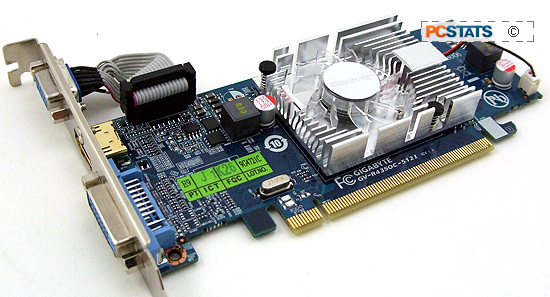
|
| Includes: |
|
User's Manual, Driver CD, Utilities CD,
low-profile I/O shield |
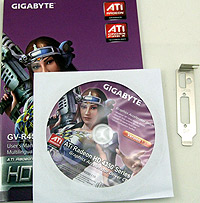 | | |
Budget Videocards For Affordable HD over
HDMI
The $50 videocard market is very different from the flagship
arena, there's more emphasis on bringing new outputs to computers that
otherwise wouldn't have them. When it comes to HTPCs, VGA is good, DVI is
better, and HDMI is best. Particularly if it's on-board instead of through an
adapter, has HDCP compliance, and can carry audio. The Gigabyte GV-R435OC-512I
can do this. After that comes heat and noise. Most home theatre and small form
factor cases are small, with limited room for cooling components. Finally, the
physical size of the card can become a factor. This usually means that full
height videocards like the Radeon
HD 4870X2, or even more reasonably sized
videocards like the Radeon HD 4850 aren't an option. You need a half-height videocard like the Gigabyte
GV-R435OC-512I.
As an entry-level video card, the GV-R435OC-512I
videocard doesn't come with a whole lot of extras - aside from a CD with the
driver and some utilities on them, the only items left in the box are a thin
manual and a half-height metal PCI bracket. The half-height riser allows you to
swap out the default full size I/O shield so the videocard can be installed into
a slim PC where a full height videocard just wouldn't fit.
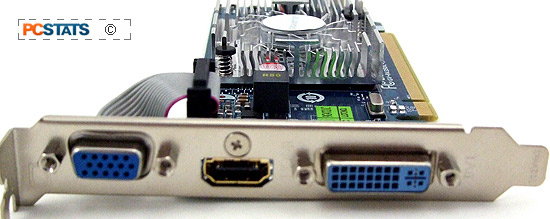
At the back of the Gigabyte GV-R435OC-512I
videocard we find Analog VGA, HDMI and DVI video outputs. Each of the outputs
can be used independently, while Analog VGA or DVI can be used in conjunction
with the HDMI output for dual displays (note that you can't use the Analog VGA
and DVI output at the same time as HDMI). The DVI is dual-linked, so it's
capable of resolutions of 2560x1600, while the HDMI is limited to 1920 x 1080.
The HDMI is HDCP compliant, and can carry
both audio and HD video from your PC out to any HDMI-compatible HD TV. I know a
lot of people will think they can just get a $8 DVI-to-HDMI adapter, and you can
if you don't need audio. Most videocards made before 2008 lack the ability to
pass the HDMI audio signal through the graphics card if a DVI-to-HDMI adaptor is
used - forcing you to run a separate coaxial audio cable to the HDTV which is
rather cumbersome.
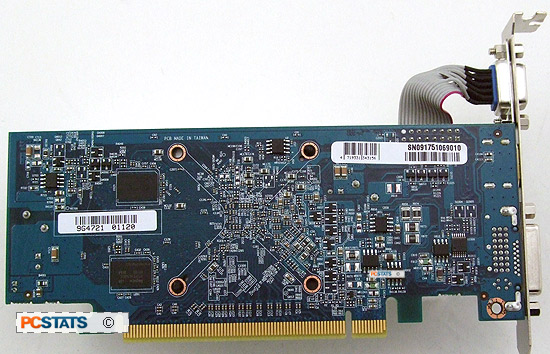
Half-Height HDMI
How does a full size videocard fit into a book-size PC
chassis? The answer is simple, it doesn't unless you have a half-height
videocard. Gigabyte gives you the option of swapping out the full-size I/O plate
with a half-height one on the Gigabyte GV-R435OC-512I videocard. This does mean
you lose access to the VGA port, which is mounted on a flexible connector. If
you don't mind a bit of mess, it can still be connected through a gap in the I/O
shield of the system chassis.
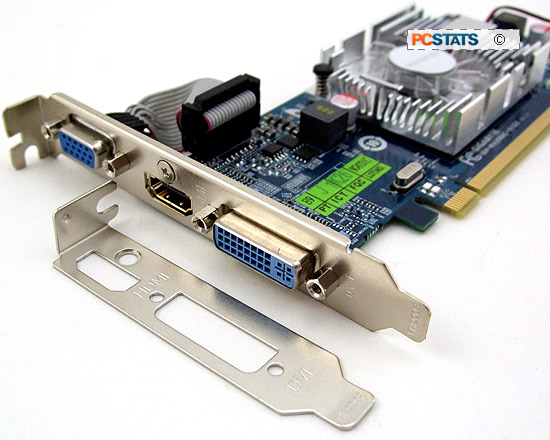
The Analog VGA connector is attached to the videocard
with flexible cable because it will be repositioned above the HDMI jack when the
half-height I/O bracket is used. In most computers there should be sufficient
space, but you might want to double check that there is an additional slot free
next the PCI Express x16. The downside to this approach is clearly that you lose
an entire slot in the computer, which is a lot given that most slim line PCs
usually only have three or four expansion slots at the most.
Of course, this card is designed to playback HD video,
so we've hooked up a nice 1080p display to see just how many CPU cycles can be
saved when moving to a dedicated graphics card.

